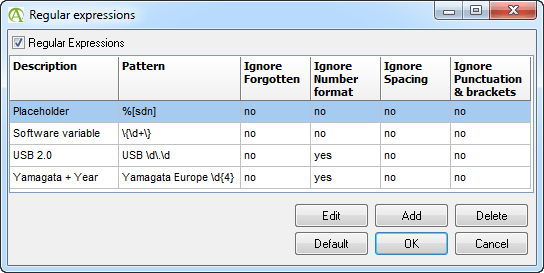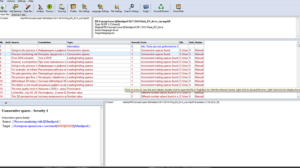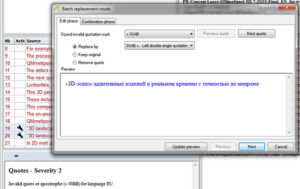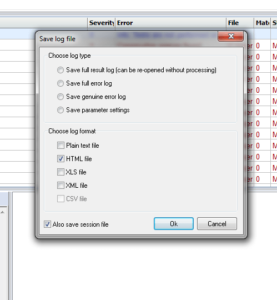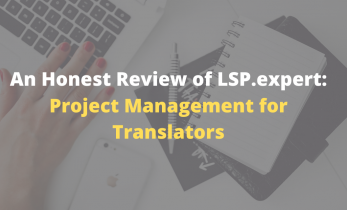Greater than 4 minutes, my friend!
QA Distiller 9: your quality ingredient Features of a professional QA tool now free for all
In April 2020, Belgium-based Yamagata Europe released QA Distiller 9.3.5 and announced that the software is free from now on. You can download it on the developer’s website (free of charge with donation to Translators without Borders encouraged).
The free version includes all QA Distiller features of what was previously the Professional License priced about $1000. Regular software updates are available without a support contract. QA Distiller supports over 90 languages including Klingon. If needed, Yamagata Europe is ready do provide basic usability support (extended support will be on a paid basis).
The stand-alone tool finds translation mistakes in bilingual files offering direct link to errors to correct them in the file format’s proprietary editor or the internal X-Editor. After analysing a bilingual file or a translation memory file, the system creates list of potential errors. To correct an error, double click the entry and edit the original segment.
Additional opportunities include regular expressions syntax support (Perl Compatible Regular Expressions library) and full customization with different profiles for different checks and customers.
System requirements:
Operating System – Microsoft® Windows 7 (32-bit and 64-bit) or higher
Minimum Hardware – 2 GHz Processor, 512 MB RAM, 50 MB of free hard disk space
Companion Software – TagEditor 5.5 or higher if you want to edit TTX files
Supported formats:
- TRADOStag (TTX files)
- TMX (Translation Memory eXchange) v 1, 1.4, 1.4b
- XLIFF
- Standard XLIFF
- SDL Trados Studio XLIFF
- memoQ XLIFF
- Worldserver XLIFF
- Wordbee XLIFF
- Memsource XLIFF
- XTM XLIFF
- Catalyst XLIFF
- Déjà Vu XLIFF
- Fluency Now XLIFF
- DICT
- TBX (TermBase eXchange)
QA Distiller does not work with bilingual Word files.
Below you will find a brief description of the main QA Distiller features.
1. Setting the parameters for checking: the QA Settings button
The QA Settings windows offers the types of mistakes the software handles.
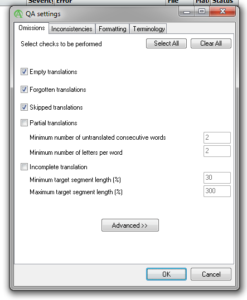 The Omissions tab: empty, skipped and partial translations, incomplete translations with percent from minimum and maximum target length.
The Omissions tab: empty, skipped and partial translations, incomplete translations with percent from minimum and maximum target length.
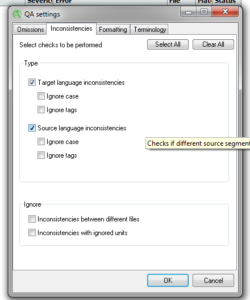 The Inconsistencies tab: options for target and (or) source languages. You can skip translation checks in different files or ignored segments.
The Inconsistencies tab: options for target and (or) source languages. You can skip translation checks in different files or ignored segments.
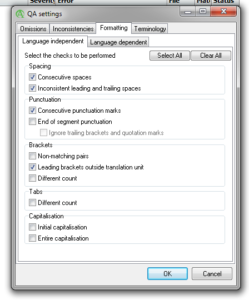 The Formatting tab: language-independent checks of spacing and punctuation, formatting of numbers, brackets, tabs and capitalisation. Language-dependent options include corrupt characters and mistakes in spaces, number values and formatting, quotation marks, measurement system conversion.
The Formatting tab: language-independent checks of spacing and punctuation, formatting of numbers, brackets, tabs and capitalisation. Language-dependent options include corrupt characters and mistakes in spaces, number values and formatting, quotation marks, measurement system conversion.
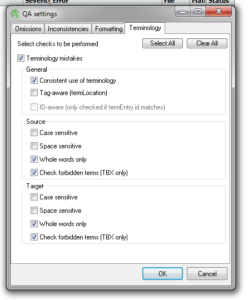 The Terminology tab: TBX and DICT files are used for checking terminology. (DICT is a proprietary format for dictionaries). You can activate checks for forbidden terms usage. If you uncheck the Whole words only option, you will get fewer false alerts because of changing word endings (an important option for languages like Russian).
The Terminology tab: TBX and DICT files are used for checking terminology. (DICT is a proprietary format for dictionaries). You can activate checks for forbidden terms usage. If you uncheck the Whole words only option, you will get fewer false alerts because of changing word endings (an important option for languages like Russian).
Note. You can use a built-in tool of QA Distiller to create DICT bases from a two-column list in Excel. TBX files can be created from Open Office Calc (a downloadable XML Filter Package is required) or exported from SDL Multiterm and TermWeb.
2. The Language/File Settings button
In the Language Settings windows you can set a language for file checking and use tabs with additional parameters:
- Numbers – Measurement system, digit grouping symbols, numbers allowed (or not allowed) to be written as words.
- Spacing – Detecting extra and missing spaces. QA Distiller supports both usual and non-breaking spaces including non-breaking spaces before measurement units or the percentage sign.
- Quotation Marks – Valid quotations marks and apostrophes set as unicode values.
- Allowed Characters – You can import characters in a file.
- Untranslatables – You add new options manually.
- RegEx – Options for working with regular expressions that help make the checks more reliable and reduce the number of false alerts.
Note. You will find additional info on RegEx here:
- http://www.qa-distiller.com/files/CheatSheet.pdf
- http://www.codeproject.com/Articles/9099/The-30-Minute-Regex-Tutorial
- http://www.regular-expressions.info/
- http://regexlib.com/CheatSheet.aspx
Some examples of using RegEx expressions for checking formatting.
(d{2})/(d{2})/(d{4}) 05/19/2012 vs. 5/19/2012
(d{1,2})/(d{2})/(d{4}) 05/19/2012 и 5/19/2012
[0-9]{1,}% 7 5% vs. 75 %
[0-9]{1,}smm 25 mm vs. 25mm
d[s]*-[s]*d 5 – 6 vs. 5-6
ISOsd+ ISO 3000 vs. ISO3000
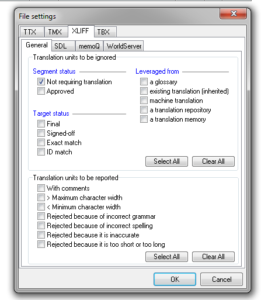 Open the File Settings window to change settings for different files types: TTX, TMX, XLIFF, TBX.
Open the File Settings window to change settings for different files types: TTX, TMX, XLIFF, TBX.
For instance, you can ignore segments with the defined match rate in TTX files. The settings for XLIFF files include General, SDL, memoQ, and World Server categories.
The spelling and grammar checks are not available in QA Distiller.
3. Checking the file and correcting mistakes
Add files using the Add files button. Supported formats include TTX, XLIFF, TMX and dict + tbx dictionaries.
Click the Process button. You will see a list of possible errors.
To correct a mistake, double click the line in the error report. Make corrections in the X-Editor window that opens and save them (<Ctrl + S>).
Use the wrench icon to add false positives to the Untranslatable lists. You can also correct multiple errors in number formatting and quotation marks in one batch. All you need to do is to select the errors and right-click the wrench icon.
4. Saving a report
The Save log button creates a report with checking settings and a list of found mistakes. All you need is to choose the log type and format.
Useful links
QA Distiller help files and QA Distiller FAQ
How to correct wrong quotation marks in one go using QA Distiller (video)
How to check Windows terminology in QA Distiller (video)
Creating a dictionary with Microsoft Excel
Do you work with QA Distiller and find it useful? Please share your favourite functions. (I haven’t tested the software heavily yet.)


